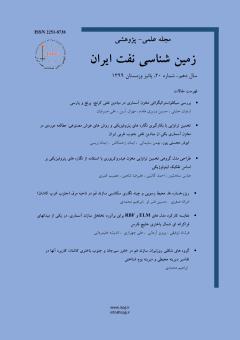مورفوگروپهاي فرامينيفري سازند قم در شرق سيرجان و جنوب غربي کاشان: کاربرد آنها در تفاسير ديرينه محيطي و پالئواکولوژيکي
محورهای موضوعی : Geoscience Fields in relation with Petroleum Geology
1 - دانشگاه تحصيلات تکميلي صنعتي و فناوري پيشرفته، کرمان
کلید واژه: سازند قم, اليگو-ميوسن, اپي¬, فونال, مورفولوژي پوسته, پالئواکولوژي, استراتژي تغذيه,
چکیده مقاله :
سازند قم مهمترين سنگ مخزن و سنگ منشاء هيدروکربور در ايران مرکزي است. فرامينيفرها در حال حاضر پايه و اساس توانايي ما براي تعيين سن، تطابق و بررسي حوضههاي رسوبي هستند که امروزه به عنوان کليدي براي رفاه اقتصادي جهان در نظر گرفته مي شوند. آناليز مورفوگروپها، به دليل مستقل بودن از تاکسونومي گونهها و همچنين امکان مقايسه تجمعاتي با سنين مختلف ابزار مناسبي براي تفاسير اکولوژيکي و پالئواکولوژيکي محسوب ميگردد. مطالعه فرامينيفرهاي سازند قم در برش بوجان (شرق سيرجان، با سن روپلين- شاتين و 156 متر ضخامت) و برش ورکان (جنوب غربي کاشان؛ با سن روپلين و 190 متر ضخامت)، منجر به تشخيص هفت مورفوگروپ شد. شناسايي مورفوگروپها بر اساس مورفولوژي و معماري پوسته (شامل شکل کلي، الگوي پيچش و آرايش و تعداد حجرات)، و زيستگاه استنباطي که يا در سطح رسوبات زندگي ميکند يا در داخل رسوبات (اپيفونال/سطح زي يا اينفونال/درونزي) و استراتژي تغذيه (معلق/رسوب خوار، گياهخوار و غيره) استوار بوده است. در هر دو برش بهطورکلي فرمهاي اپيفونال غالب بودهاند. آناليز مورفوگروپها بيانگر وجود نوساناتي در درصد مورفوگروپ-هاي غالب است، که خود بيانگر نوساناتي در شرايط اکولوژيکي محيط ميباشد. در برش بوجان در نهشتههاي روپلين مورفوگورپ هاي با ديواره پورسلانوز و در شاتين مورفوگورپهاي با ديواره هيالين فراواني بيشتري دارند که بيانگر نهشته شدن بخشهاي پاييني در محيطهاي لاگوني و نهشته شدن بخشهاي بالايي برش (عمدتاً) در رمپ مياني است. اين تغيير چشمگير در طول زمان بيانگر افزايش تدريجي عمق حوضه، کاهش شوري، کاهش روشنايي و کاهش مواد مغذي است. غالب بودن مورفوگورپهاي با ديواره هيالين در سرتاسر برش ورکان بيانگر رسوبگذاري اين برش (عمدتاً) در محيطهاي رمپ مياني با ميزان شوري نرمال دريايي و تحت شرايط نوري مزوفوتيک تا اليگوفوتيک ميباشد.
The Qom Formation is the main reservoir and source rock of hydrocarbons in central Iran. Foraminifera are now central to our ability to date, correlate and analyse the sedimentary basins that are currently key to the economic wellbeing of the world. Morphogroup analysis, due to independence of species level taxonomy, as wel as permit to comparison of assemblages of differing ages, is a useful tool for ecological and palaeoecological interpretation. It is independent of species level taxonomy and is thus relatively elementary to translate from one worker to another. Foramniferal study of the Qom Formation in the Bujan (eastern Sirjan; with Rupelin-Chattian in age and 156 m thickness) and Varkan (southwestern Kashan; with Rupelin in age and 190 m thickness) sections resulted in identification of seven morphogroups. The morphogroups were distinguished according to test/shell morphology and architecture (general shape, mode of coiling, and arrangement and number of chambers), inferred life habitat either living on the surface of the sediments or within the sediments (epifaunal and infaunal), and feeding strategy (suspension-feeder, herbivore, etc.). Generaly, epifaunal morphogroups were dominated in both study sections. The morphogroup analyses showed variations in the percentage of the dominant morphotypes, suggesting fluctuations in the paleoecological conditions. In the Bujan section, the Rupelin deposits are dominated by calcareous porcelaneous morphogroups; while the Chattian deposits are dominated by hyaline morphogroups, which indicates the lower and upper parts were deposited in inner ramp (lagoonal environments) and middle ramps, respectively. This significant change through time reffers to gradual increasing of the basin depth, decreasing the light intensity, reducing the salinity and decreacing the nutrient level. De dominance of the hyaline morphogroups throughout of the Varkan section is indicative of the deposition in middle ramp environments with normal salinity under meso-photic to oligo-photic conditions.
